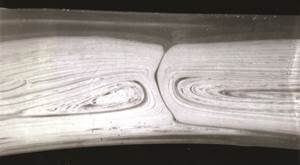Injection Molding: Production Monitoring System Built for Simplicity, Affordability
Smart Attend reportedly installs in 2-4 hr and boosts productivity by 10-20% within two weeks.
Production monitoring systems are increasingly popular in molding and extrusion plants. And for good reason: If evidence from metalworking machine shops is any indicator of conditions in plastics processing, then more than 80% of current manufacturing data is often lost or under-utilized, and this can cost manufacturers thousands of dollars a month per machine due to inefficiencies not perceived or not promptly diagnosed for lack of data. And manual production-data reporting systems are time-consuming and prone to errors.
One experienced injection molder wanted an automated system, but considered the available options too costly and too complex, requiring weeks of personnel training and expensive installation. So he built a team of experienced manufacturing professionals and created his own. Called Smart Attend, the system was in development for two years and was launched commercially last June by a company of the same name, based in Aurora, Ont.
Smart Attend collects data (such as 24V I/O signals) produced by injection machines, extruders, or other machinery and connects to the plant’s WiFi network to send data to PCs via web browser login or to mobile devices via the Smart Attend app for iOS or Android. Data is collected by a small, WiFi-enabled box called a Smart Device, which sends encrypted data to a secure “cloud” server. A backup 2 GB memory card ensures that data is never lost and can be collected in the event of a network disconnect. Also included is a special “tower light” with 150 LEDs capable of flashing a wide variety of colors to signal the state of the machine and production.
Initial registration and setup of the system can be done on a PC through a micro USB cable. Further Smart Attend settings can be configured directly over the network via the app. Utilizing “plug-and-play” functionality, initial configuration can be completed in as little as 20 min without requiring IT or specially trained personnel. Overall installation time averages 2-4 hr, says Max Preston, Smart Attend dir. of sales and marketing. He says the Smart Attend system can work with any brand and any age of machine—“It helps bring old machines up to the modern age.”
Preston adds that “Big data does not equal smart data. A production-monitoring system does not need to provide a lot of data, but just crucially important data, usable data, actionable data.” One factor is immediate availability. “With Smart Attend, data goes instantly from machines to managers.”
Smart Attend provides information in three ways:
1. Visually, through the tower light, which responds to machine alarms in custom-configurable ways, with several flash, strobe, and solid-color settings. Alarms can be customized in almost any color. The light provides 360° visibility.
2. Audibly, through a powerful speaker housed at the top of the tower light, which accepts custom sound files to represent specific alarms.
3. Digitally, through the native mobile-device app and web portal. That portal not only allows remote access to all machine-based production data, but also allows export of the data to ERP or MRP systems. The Smart Attend user “dashboard” provides a quick overview of plantwide production data and the ability to home in on any individual machine. The dashboard provides data on cycle times, current machine status, part counts, alarm description and Pareto analysis, hourly incident reporting, job scheduling and tracking, and machine OEE (Overall Equipment Effectiveness, which is a single percentage number that combines ratings of machine availability, productivity performance, and good/bad part production).
Custom reports are also available for production from the last minute up to the last three years. Such reports can include alarm response times, uptime/downtime tracking, actual vs. expected productivity, and real-time benchmarking from shift to shift, week to week, or month to month.
According to Preston, beta users of Smart Attend have experienced a productivity boost of 10% to 15% or even 20% in the first two weeks of using the system:
• One customer with 26 injection machines experienced 46% average productivity improvement over the first 12 months with the system.
• An injection molder of auto parts with a global customer base, reported saving $10,000 in the first week by not having to expedite customer shipments through better production data.
• A moldmaking firm used production data to help diagnose and solve job setup and lag time problems, resulting in 12% greater uptime and quicker job completion.
• A CNC machining customer uses the sytsem to monitor machines in different buildings, resulting in 35% greater productivity and uptime on specific machines.
Related Content
What to Do About Weak Weld Lines
Weld or knit lines are perhaps the most common and difficult injection molding defect to eliminate.
Read MoreHow to Stop Flash
Flashing of a part can occur for several reasons—from variations in the process or material to tooling trouble.
Read MoreHow to Optimize Pack & Hold Times for Hot-Runner & Valve-Gated Molds
Applying a scientific method to what is typically a trial-and-error process. Part 2 of 2.
Read MoreHow to Set Barrel Zone Temps in Injection Molding
Start by picking a target melt temperature, and double-check data sheets for the resin supplier’s recommendations. Now for the rest...
Read MoreRead Next
Troubleshooting Screw and Barrel Wear in Extrusion
Extruder screws and barrels will wear over time. If you are seeing a reduction in specific rate and higher discharge temperatures, wear is the likely culprit.
Read MoreHow Polymer Melts in Single-Screw Extruders
Understanding how polymer melts in a single-screw extruder could help you optimize your screw design to eliminate defect-causing solid polymer fragments.
Read MoreUnderstanding Melting in Single-Screw Extruders
You can better visualize the melting process by “flipping” the observation point so that the barrel appears to be turning clockwise around a stationary screw.
Read More







 (2).jpg;maxWidth=300;quality=90)

















